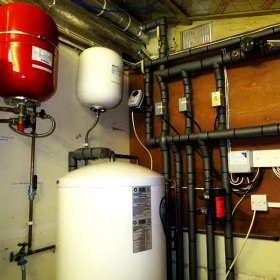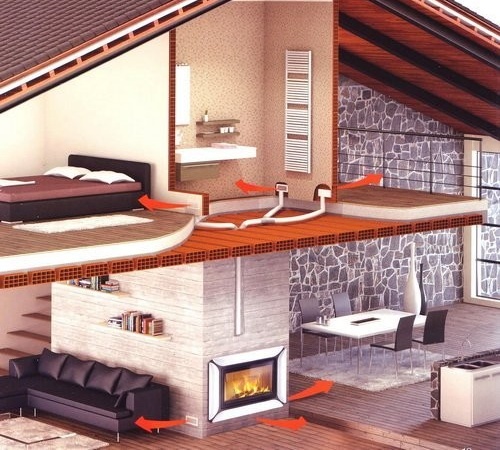Choosing a heating system for the cottage: what is the best way to heat your home?

Cottages erected outside the city on separate plots of land or being built as part of villages are not connected to centralized heating systems. For each object autonomous heating is designed. When calculating the parameters of the heating system, the cottage area, number of storeys, features of the used building and heat-insulating materials, as well as other important factors, are taken into account. The owner of the country house adjusts the heating of the premises, based on his ideas about comfort. Economical fuel consumption, including through the installation of buffer tanks that can accumulate excess heat, can reduce the financial costs of maintaining the cottage. Indirect heating water heaters also allow optimizing the operation of the facility’s heating system, which provide residents of the cottage with hot water heated by the coolant flowing through the coil built into the domestic tank of the household appliance. Water heating of the cottage is considered the most popular option for installing autonomous heating systems for objects in the country.

The design and calculation of the cottage heating system is carried out by heat engineers who, when carrying out the work, take into account all the design features of the property being constructed
Content
The main elements of a water heating system
The main elements of a water heating system include:
- boiler;
- a device supplying air to the combustion chamber;
- equipment responsible for the removal of combustion products;
- pumping units that circulate the coolant along the heating circuit;
- pipelines and fittings (fittings, shut-off valves, etc.);
- radiators (cast iron, steel, aluminum, etc.).
Choosing a boiler by the number of circuits
For heating the cottage, you can choose a single-circuit or double-circuit boiler. What is the difference between these models of boiler equipment? A single-circuit boiler is designed only for heating the coolant intended for circulation through the heating system. Indirect heating boilers are connected to single-circuit models, which supply the object with hot water for technical purposes. In dual-circuit models, the unit is operated in two directions that do not intersect with each other. One circuit is responsible only for heating, the other for hot water.
Choosing a boiler by fuel type
The most economical and convenient type of fuel for modern boilers at all times has been and remains the main gas. Efficiency gas boilers not disputed, since their efficiency is 95%, and in some models this indicator surpasses 100%. We are talking about condensation units that can “draw” heat from the combustion products, flying away in other models simply “into the pipe”.

Heating a country cottage with a wall-mounted gas boiler is one of the most popular ways to heat a living space in gasified regions
However, not all territories are gasified, therefore, boiler equipment operating on solid and liquid fuels, as well as on electricity, is very popular. Use for heating a cottage electric boilers even more convenient and safer than gas, provided that the region has stable operation of electric networks. Many owners are stopped by the cost of electricity, as well as the restriction of its supply rate for one object. The requirement to connect an electric boiler to a three-phase network with a voltage of 380 V is also not for everyone and affordable. It is possible to make electric heating of cottages more economical by using alternative sources of electricity (windmills, solar panels and etc.).
In cottages built in remote regions, cut off from gas and electric highways, install liquid fuel boilers. Diesel fuel (diesel fuel) or used oil, if there is a source of constant replenishment, is used as fuel in these units. Solid fuel aggregates operating on coal, wood, peat briquettes, are very common. pellets and etc.

Heating of a country cottage with a solid fuel boiler operating on pellets - granulated wood pellets having a cylindrical shape and a certain size
Boiler selection by capacity
Having decided on the type of boiler equipment according to the fuel criterion, they begin to choose the boiler of the required power. The higher this indicator, the more expensive the model, so you should not miscalculate when determining the power of the unit purchased for a particular cottage. You can’t follow the path: the less, the better. Since in this case the equipment cannot fully cope with the task of heating the entire area of a country house to a comfortable temperature.
Particularly low power of the unit will manifest itself on cold days, when the thermometer will show abnormally low temperatures outside the window. Therefore, it is recommended to purchase boilers with a slightly higher power than the calculations show, but not significantly higher. Why overpay for money, and then make the equipment work “idle”?
We bring to your attention our free online calculator, with which you can roughly estimate the boiler power for your home:
Installation of boiler equipment
For heating large-area cottages, powerful boilers are required, which are produced for stationary (floor) placement. Such massive equipment should be in a separate room - a boiler room. During the construction of the cottage, the place for the boiler room is selected in advance (at the stage of preparation of project documentation). Boilers are installed on a solid concrete base, aligned to the construction level.Buffer tanks are also located in the boiler room, which accumulate heat or indirectly heat hot water for domestic purposes.

Schematic layout of the entire complex of equipment necessary for the operation of the heating system in the boiler room - a separate room, the presence of which is provided for in the cottage project
In the boiler room must be provided for the presence of effective ventilation. Fresh air is supplied from the street through the inlet, the size of which is calculated taking into account the power of the boiler: for 1 kW - 600 sq. millimeters. When designing the boiler room, the issue of the location of the chimney connected to the outlet of the boiler’s chimney is also considered.
Chimney provides traction that helps maintain the combustion process in the boiler. The installation of a draft stabilizer ensures uninterrupted operation of boiler equipment. During the construction of cottages, coaxial chimneys are increasingly used, the special design of which allows you to simultaneously supply fresh air to the boiler and to remove combustion products.
In small cottages, you can not allocate space for the boiler room, but use compact wall mounted gas boilersthat can even be located in the kitchen.
Safe operation of boiler equipment
Masters, when installing the heating of the cottage, include a “security group” in the heating system, if such devices are not provided for in the design of the boiler. The safety elements for the operation of boiler equipment include the following elements:
- expansion membrane tank;
- pressure gauge;
- safety valve;
- automatic air vents.
The models of domestic heating boilers currently being implemented are supplied by the manufacturer with regulating automation, as well as an expansion tank and even a circulation pump built into the unit design. Modern boilers differ from previous generations in a greater degree of automation. Operation of the equipment is much simpler and safer if the boiler has a system:
- electronic ignition endowed with the function of flame control;
- protection against insufficient gas pressure in the supply line;
- protection against scaling and freezing;
- automatic diagnosis of the state of the unit;
- climate control in the room (automatic change of boiler operation mode depending on the outdoor temperature).
Selection of pipes, radiators and other system components
Thinking through the water heating system for the cottage, you have to determine not only the boiler equipment, but also the pipe layout. For the full heating of country houses, two-pipe pipe wiring is used with mandatory use circulation pumpbuilt into the boiler or specially embedded in the "return". When choosing a circulation pump, it is worth taking a closer look at frequency-controlled models that can change the speed of operation in direct proportion to the cottage's heat demand. This function allows not only to save electricity, but also to increase the resource of the entire autonomous heating system of a suburban facility.

Two-pipe wiring of heating in a private house or country cottage allows for uniform heating of all rooms, regardless of the degree of their removal from the boiler
Having decided on the wiring diagram, proceed to the choice of the type of pipes and radiators. Previously, steel pipes and cast-iron radiators were used to construct the water heating system. Nowadays, polypropylene or metal-plastic pipes, which surpass steel products in terms of service life and corrosion resistance, are more popular. Due to the light weight of polymer pipes, the installation of the system is greatly simplified.You can also make a pipeline of copper pipes, if the owner of the cottage has a sufficient budget for the installation of a heating system from expensive materials.
Now you should talk about choosing radiators. Once upon a time, it was difficult to find a worthy replacement for pig-iron accordion radiators. Now manufacturers of heating appliances offer individual developers to use the following types of these products when installing heating systems:
- steel or aluminum radiators that lose to cast-iron batteries in terms of heat transfer time, but win in weight and external (very attractive) design.
- "Bimetallic" radiators, combining in their construction a steel core with aluminum fins that improve the heat transfer of the device.
Modern radiators complement thermostats (automatic temperature controllers), allowing you to set the temperature in each room that is optimal for living.

Selection and installation of beautiful compact sectional or panel-type radiators for mounting a heating system in a cottage
Underfloor heating as an alternative
It is impossible to imagine heating a modern cottage without using underfloor heating systemsused in all rooms of a suburban facility or only in separate rooms (nurseries, bedrooms, bathrooms, etc.). In cottages, it is possible to install water-heated underfloor heating without any permissions required by the owners of the apartments. Using this method of heating the interior of the house allows you to get away from installing radiators that spoil the look of the interior with your presence. Water floors are "hidden" in a concrete screed, which acts as a heat source.
We hope that in this article we managed to reveal the secrets of possible ways of heating cottages. By choosing a water heating system for a country house using underfloor heating, you can provide comfort in the living space throughout the calendar year.



2 comments